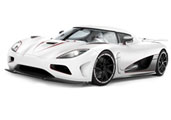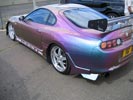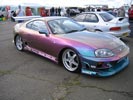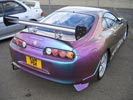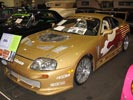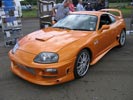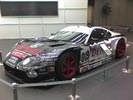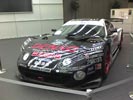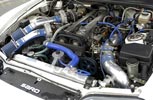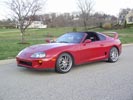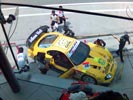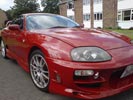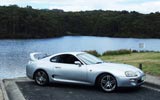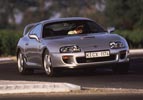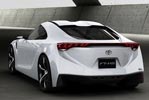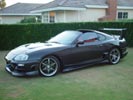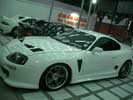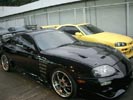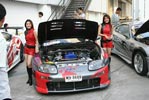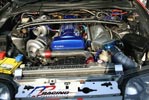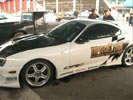The Toyota Supra was a sports car/grand tourer produced by Toyota Motor Company from 1979 to 2002. The styling of the Toyota Supra was derived from the Toyota Celica, but it was both longer and wider. Starting in mid-1986, the Toyota Supra (in its third generation, MKIII) became its own model and was no longer based on the Toyota Celica.
As an iconic sportscar, the Toyota Supra has appeared in numerous video games, movies, music videos and TV shows. Some of the most notable appearances include the Gran Turismo and Need for Speed series of video games and the 2001 film, The Fast and the Furious.
With the fourth generation of the Supra, Toyota took a big leap in the direction of a more serious high performance car. Production started in December 1992 with only 20 models, but started mass production in April 1993. The new Toyota Supra was completely redesigned, with rounded body styling and featured two new engines: a naturally aspirated 2JZ-GE producing Template:Convert/198kW @5800 rpm and 210 lb·ft (285 N·m) @4800 rpm of torque and a twin turbocharged 2JZ-GTE making 280 ps (296 kW) and 318 ft·lbf (430 N·m) of torque for the Japanese version. For the export model (America/Europe) Toyota upgraded the Supra turbo's engine (smaller, steel wheeled turbochargers, bigger fuel injectors, etc.). This increased the power output. The turbocharged variant could achieve 0-60 mph in as low as 4.6 seconds and 1/4 mile (402 m) in 13.1 seconds at 109 mph (175 km/h). The turbo version was tested to reach over 291 km/h (180 mph) all-stock, but the cars are restricted to just 180 km/h in Japan and 250 elsewhere. European versions also had an air intake on the bonnet (hood). Drag coefficient is .31 for the normally aspirated models and .32 for the turbo models.
The MKIV Supra's twin turbos operated in sequential mode instead of the more common parallel mode. The sequential setup featured a pair of turbos, with ceramic blades for the domestic Japanese market and steel blades for export (USA, Europe) markets. Initially all of the exhaust is routed to the first turbine for reduced lag. This resulted in boost and enhanced torque as early as 1800 rpm. Approaching 3500 rpm, some of the exhaust is routed to the second turbine for a "pre-boost" mode, although none of the compressor output is used by the engine at this point. Approaching 4000 rpm, the second turbo's output is used to augment the first turbo's output. As opposed to the parallel mode, the sequential turbos provides quicker low RPM response and increased high RPM boost. The valve seal problem was back from the Mark II engines. Another weakness is the engine mounts.
For this generation, the Toyota Supra received a new 6-speed Getrag/Toyota gearbox on the Turbo models while the naturally aspirated models made do with a 5-speed manual. Both models were offered with a 4-speed automatic with a manumatic mode. However, the turbo model utilized larger 4-piston brake calipers on the front and 2-piston calipers for the rear. The base model used smaller 2-piston calipers for the front and a single piston caliper for the rear. The turbo models were fitted with 235/45/17 tires on the front and 255/40/17 tires for the rear. The base model used 225/50/16 for the front and 245/50/16 for the rears.
Toyota took measures to reduce the weight of the current model compared to the previous model. Aluminium was used for the hood, targa top (if so equipped), front crossmember, oil and transmission pans, and the suspension upper A-arms. Other measures included dished out head bolts, hollow carpet fibers, magnesium steering wheel, plastic gas tank and lid, gas injected rear spoiler, and a single pipe exhaust. Despite having more features such as dual airbags, traction control, larger brakes, larger wheels, larger tires, and an additional turbo, the car was at least 200 lb lighter than its predecessor. The base model with a manual transmission had a curb weight of 3210 lb. The Sport Roof added 40 lb while the automatic transmission added 55 lb. It had 51% of its weight up front and 49% to the rear wheels. The turbo model came in as 3505 lb with the manual and the automatic added another 10 lb. The front wheels held 53% of the weight and the rear wheels had 47% of the weight.
For the 1996 Toyota Supra model year in the U.S., the turbo model was only available with the automatic transmission due to OBD2 certification requirements. The targa roof was made standard on all turbo models. For 1997, the manual transmission returned for the optional engine along with a redesign of the tail lights, headlights, front fascia, chromed wheels, and other minor changes such as the radio and steering wheel designs. The SZ-R model was also updated with the introduction of a six-speed Getrag transmission, the same used for the twin-turbo RZ models. All 1997 models included badges that said, "Limited Edition 15th Anniversary." For 1998, the radio and steering wheel were redesigned once again. The naturally aspirated engine was enhanced with VVTI which raised the output by 5 hp (4 kW) and 10 lb·ft (14 N·m) of torque. The turbo model was not available in California, New Jersey, New York and Massachusetts due to increased emission regulations. In Japan, the turbo engines were installed with VVTI as well.
The stock MKIV Supra chassis has also proven an effective platform for roadracing, with several top 20 and top 10 One Lap Of America finishes in the SSGT1 class. The Supra is one of the heavier 2-door Japanese sports cars, however still lighter than the Nissan R33 and R34 Skyline GTRs to which the Supra is traditionally a rival in its home country. The Supra was also lighter than the Mitsubishi 3000GT VR4 and the Nissan 300ZX Turbo. Despite its curb weight, in 1994 the MKIV managed a remarkable skidpad rating of 0.95 lateral g's (200ft) or 0.98 lateral g's (300ft) due in part to a four-sensor four-channel track tuned ABS system with yaw control whereby each caliper is sensored and the brakes are controlled individually according to the speed, angle, and pitch of the approaching corner. This unique Formula One inspired braking system allowed the Supra Turbo to record a 70-0 braking distance of 149 feet (45 m), the best braking performance of any production car tested in 1997 by Car and Driver magazine. This record was finally broken in 2004 by 3 feet by a Porsche Carrera GT.
Car - Toyota Supra
Copyright © 1998-2013 you.com.au

